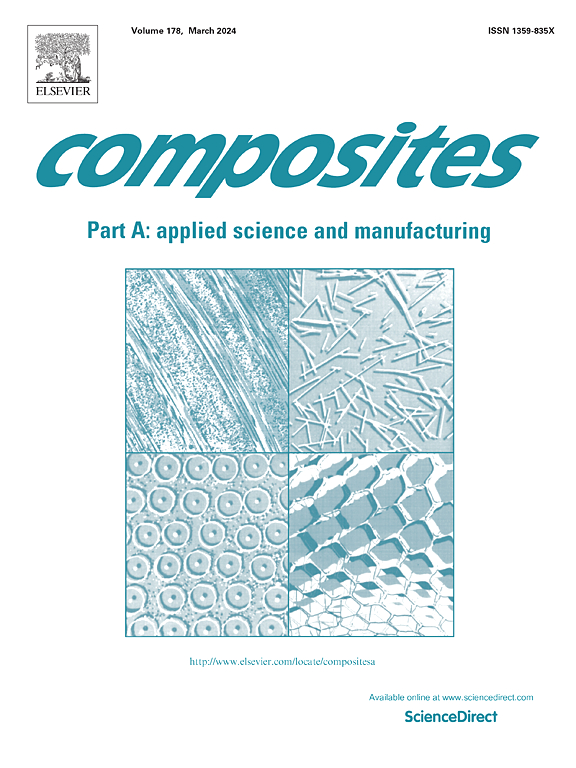Multi-crosslinked Ta4C3TX MXene composites with “interlocked structure” for efficient gamma-ray shielding, behavioural detection and thermal management in nuclear environments
IF 8.1
2区 材料科学
Q1 ENGINEERING, MANUFACTURING
Composites Part A: Applied Science and Manufacturing
Pub Date : 2024-11-16
DOI:10.1016/j.compositesa.2024.108597
引用次数: 0
Abstract
The creation of wearable protection materials with optimal overall performance is essential to meet the requirements of nuclear workers. Here, multilayer composites with “interlocked structure” were prepared by vacuum filtration and layer-by-layer assembly using Ta4C3TX MXene as filling, multi-crosslinked elastomers as matrix, and abrasive cloths as templates. To enhance the scattering attenuation, we constructed an alternating structure from two levels. When the template was 60 mesh, composites exhibited tensile strength at 8.95 MPa, tearing resistance at 72.59 N, and pull-out strength at 5.16 MPa. Gauge factor reached 19.41. Furthermore, the temperature of the composites could rise up to 88.5°C under a load of 1 sun and 1 V voltage, the mass attenuation coefficient for 59.6 KeV γ-rays was found to be 0.927 cm2/g. These indicate that the composites have excellent behavioural monitoring, thermal management and radiation protection capabilities, and have a wide range of applications within low-temperature nuclear environments.

具有 "互锁结构 "的多交联 Ta4C3TX MXene 复合材料,用于核环境中的高效伽马射线屏蔽、行为检测和热管理
要满足核工作人员的要求,就必须制造出具有最佳综合性能的可穿戴防护材料。在这里,我们以 Ta4C3TX MXene 为填充物、多交联弹性体为基体、砂布为模板,通过真空过滤和逐层组装制备了具有 "交错结构 "的多层复合材料。为了增强散射衰减,我们从两个层面构建了一种交替结构。当模板为 60 目时,复合材料的抗拉强度为 8.95 兆帕,抗撕裂强度为 72.59 牛顿,抗拉强度为 5.16 兆帕。测量系数达到 19.41。此外,在 1 个太阳和 1 V 电压的负载下,复合材料的温度可升至 88.5°C,对 59.6 KeV γ 射线的质量衰减系数为 0.927 cm2/g。这些结果表明,这种复合材料具有出色的行为监测、热管理和辐射防护能力,可在低温核环境中广泛应用。
本文章由计算机程序翻译,如有差异,请以英文原文为准。
求助全文
约1分钟内获得全文
求助全文
来源期刊

Composites Part A: Applied Science and Manufacturing
工程技术-材料科学:复合
CiteScore
15.20
自引率
5.70%
发文量
492
审稿时长
30 days
期刊介绍:
Composites Part A: Applied Science and Manufacturing is a comprehensive journal that publishes original research papers, review articles, case studies, short communications, and letters covering various aspects of composite materials science and technology. This includes fibrous and particulate reinforcements in polymeric, metallic, and ceramic matrices, as well as 'natural' composites like wood and biological materials. The journal addresses topics such as properties, design, and manufacture of reinforcing fibers and particles, novel architectures and concepts, multifunctional composites, advancements in fabrication and processing, manufacturing science, process modeling, experimental mechanics, microstructural characterization, interfaces, prediction and measurement of mechanical, physical, and chemical behavior, and performance in service. Additionally, articles on economic and commercial aspects, design, and case studies are welcomed. All submissions undergo rigorous peer review to ensure they contribute significantly and innovatively, maintaining high standards for content and presentation. The editorial team aims to expedite the review process for prompt publication.
 求助内容:
求助内容: 应助结果提醒方式:
应助结果提醒方式:


